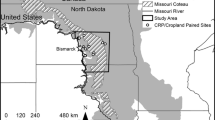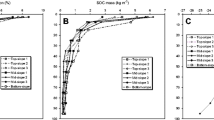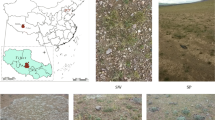Abstract
Reed canary grass (Phalaris arundinacea) invasion is prevalent in wetlands and riparian fringes, and due to differences in vegetative growth and residue quality relative to native species, P. arundinacea invasion could result in measurable effect on soil organic carbon (SOC) pools and composition. To examine these questions, plant biomass and soil samples were collected from areas invaded by P. arundinacea and areas colonized either by a native sedge Scirpus cyperinus or a mixed assemblage of 22 native species in a south-central Indiana (USA) wetland. Plant biomass composition (C, N, cellulose, lignin, and phenolics), total and water-extractable SOC pools were determined. S. cyperinus biomass contained (g kg−1 biomass) significantly (P < 0.05) more lignin (142.5 vs 72), phenolics (29.2 vs 11.2), and cellulose (260.5 vs 164.8) than P. arundinacea biomass. These constituents were also more abundant in mixed native plant material than in P. arundinacea biomass. Decomposition of plant biomass was related to residue composition with P. arundinacea shoot biomass decomposing 1.6 times faster than S. cyperinus material. SOC pools (Mg C ha−1, 0–30 cm) were larger under P. arundinacea (28.3) than under either S. cyperinus (23.9) or the mixed native species (21.8). Thus, the greater recalcitrance of native plant biomass did not translate into larger SOC pools. Furthermore, water-extractable organic C, N, and carbohydrates were significantly higher in the surface layer of soils supporting P. arundinacea than in native species. These results therefore indicate a clear effect of P. arundinacea invasion on the cycling and composition of soil organic matter at the study site.




Similar content being viewed by others
References
Abiven S, Menasseri S, Angers DA, Leterme P (2007) Dynamics of aggregate stability and biological binding agents during decomposition of organic materials. Eur J Soil Sci 58:239–247
Bärlocher F, Graça MAS (2005) Total phenolics. In: Graça MAS, Barlocher F, Gessner MO (eds) Methods to study litter decomposition: a practical guide. Springer, Dordrecht, pp 97–99
Beare MH, Hu S, Coleman DC, Hendrix PF (1997) Influences of mycelial fungi on soil aggregation and organic matter storage in conventional and no-tillage soils. Appl Soil Ecol 5:211–219
Berg B (2000) Litter decomposition and organic matter turnover in northern forest soils. Forest Ecol Manag 133:13–22
Drury CF, Stone JA, Findlay WI (1991) Microbial biomass and soil structure associated with corn, grasses and legumes. Soil Sci Soc Am J 55:805–811
Evans RD, Rimer R, Sperry L, Belnap J (2001) Exotic Plant invasion alters nitrogen dynamics in an arid grassland. Ecol Appl 11:1301–1310
Fog K (1988) The effect of added nitrogen on the rate of decomposition of organic matter. Biol Rev 63:433–462
Fornara DA, Tilman D (2008) Plant functional composition influences rates of soil carbon and nitrogen accumulation. J Ecol 96:314–322
Franzluebbers AJ, Nazih N, Stuedemann JA, Fuhrmann JJ, Schomberg HH, Hartel PG (1999) Soil carbon and nitrogen pools under low- and high-endophyte-infected tall fescue. Soil Sci Soc Am J 63:1687–1694
Frey SD, Elliott ET, Paustian K (1999) Bacterial and fungal abundance and biomass in conventional and no-tillage agroecosystems along two climatic gradients. Soil Biol Biochem 31:573–585
Gessner MO (2005) Proximate lignin and cellulose. In: Graça MAS, Barlocher F, Gessner MO (eds) Methods to study litter decomposition: a practical guide. Springer, Dordrecht, pp 115–120
Ghani A, Dexter M, Perrott KW (2003) Hot-water extractable carbon in soils: a sensitive measurement for determining impacts of fertilisation, grazing and cultivation. Soil Biol Biochem 35:1231–1243
Green EK, Galatowitsch SM (2001) Differences in wetland plant community establishment with additions of nitrate-N and invasive species (Phalaris arundinacea and Typha xglauca). Can J Bot 79:170–178
Gregorich EG, Beare MH, Stoklas U, St-Georges P (2003) Biodegradability of soluble organic matter in maize-cropped soils. Geoderma 113:237–252
Guggenberger G, Frey SD, Six J, Paustian K, Elliott ET (1999) Bacterial and fungal cell-wall residues in conventional and no-tillage agroecosystems. Soil Sci Soc Am J 63:1188–1198
Harris MM, Safford LO (1996) Effects of season and four tree species on soluble carbon content in fresh and decomposing litter of temperate forests. Soil Sci 161:130–135
Hook PB, Olsen BE, Wraith JM (2004) Effects of the invasive forb Centaura maculosa on grassland carbon and nitrogen pools in Montana, USA. Ecosystems 7:686–694
Indiana State Climate Office (2008) Monthly/Annual Climate Summary—Station 120784, Bloomington, Indiana
Jacinthe PA, Bills JS, Tedesco LP (2010) Size, activity, and catabolic diversity in a wetland complex invaded by reed canary grass. Plant Soil 329:227–238
Jandl R, Lindner M, Vesterdal L, Baewens B, Baritz R, Hagedorn F, Johnson DW, Minkkinen K, Byrne KA (2007) How strongly can forest management influence soil carbon sequestration? Geoderma 137:253–268
Kercher SM, Carpenter QJ, Zedler JB (2004) Interelationships of hydrologic disturbance, reed canary grass (Phalaris arundinacea L.), and native plants in Wisconsin wet meadows. Nat Areas J 24:316–325
Lavergne S, Molofsky J (2004) Reed canary grass (Phalaris arundinacea) as a biological model in the study of plant invasions. Crit Rev Plant Sci 23:415–429
Liao C, Luo Y, Jiang L, Zhou X, Wu X, Fang C, Cheng J, Li B (2007) Invasion of Spartina alterniflora enhanced ecosystem carbon and nitrogen stocks in the Yangtze estuary, China. Ecosystems 10:1351–1361
Martens DA (2000) Plant residue biochemistry regulates soil carbon cycling and carbon sequestration. Soil Biol Biochem 32:361–369
Monreal CM, Schnitzer M, Schulten HR, Campbell CA, Anderson DW (1995) Soil organic structures in macro and microaggregates of a cultivated Brown Chernozem. Soil Biol Biochem 27:845–853
Potter CS, Klooster SA (1997) Global model estimates of carbon and nitrogen storage in litter and soil pools: response to changes in vegetation quality and biomass allocation. Tellus Ser B 49:1–17
Puget P, Angers DA, Chenu C (1999) Nature of carbohydrates associated with water-stable aggregates of two cultivated soils. Soil Biol Biochem 31:55–63
Safarik I, Santruckova H (1992) Direct determination of total soil carbohydrate content. Plant Soil 143:109–114
Saggar S, McIntosh PD, Hedley CB, Knicker H (1999) Changes in soil microbial biomass, metabolic quotient, and organic matter turnover under Hieracium (H-pilosella L.). Biol Fertil Soils 30:232–238
Sakamoto K, Oba Y (1994) Effect of fungal to bacterial biomass ratio on the relationship between CO2 evolution and total soil microbial biomass. Biol Fertil Soils 17:39–44
Schulten HR, Leinweber P (2000) New insights into organic-mineral particles: composition, properties and models of molecular structure. Biol Fertil Soils 30:399–432
Stevenson FJ (1994) Humus chemistry: genesis, composition, reactions. Wiley, New York
Thornbury WD (1950) Glacial sluiceways and lacustrine plains of southern Indiana. Bulletin no. 4. Division of Geology, Indiana Department of Conservation, Bloomington, Indiana
Tiner RW (1999) Wetland indicators: a guide to wetland identification, delineation, classification, and mapping. Lewis Publishers, Boca Raton
Von Lutzow M, Koegel-Knabner I (2009) Temperature sensitivity of soil organic matter decomposition—what do we know? Biol Fertil Soils 46:1–16
Wittenberg KM, Duynisveld GW, Tosi HR (1992) Comparison of alkaloid content and nutritive value for tryptamine-free and beta-carboline-free cultivars of reed canarygrass (Phalaris arundinacea). Can J Anim Sci 72:903–909
Acknowledgements
We would like to thank the Sycamore Land Trust for providing access to the study site; Andrew Mertz of Indy Parks, for his help with the vegetation survey; Dr. Peter Sauer for his assistance with C and N analysis; Dr. Philippe Vidon for his guidance throughout this study; Vince Hernly and Bob Hall for their support with field reconnaissance and well installation; all the interns from the Center for Earth and Environmental Science (IUPUI) who helped with field sampling.
Author information
Authors and Affiliations
Corresponding author
Rights and permissions
About this article
Cite this article
Bills, J.S., Jacinthe, PA. & Tedesco, L.P. Soil organic carbon pools and composition in a wetland complex invaded by reed canary grass. Biol Fertil Soils 46, 697–706 (2010). https://doi.org/10.1007/s00374-010-0476-6
Received:
Revised:
Accepted:
Published:
Issue Date:
DOI: https://doi.org/10.1007/s00374-010-0476-6




